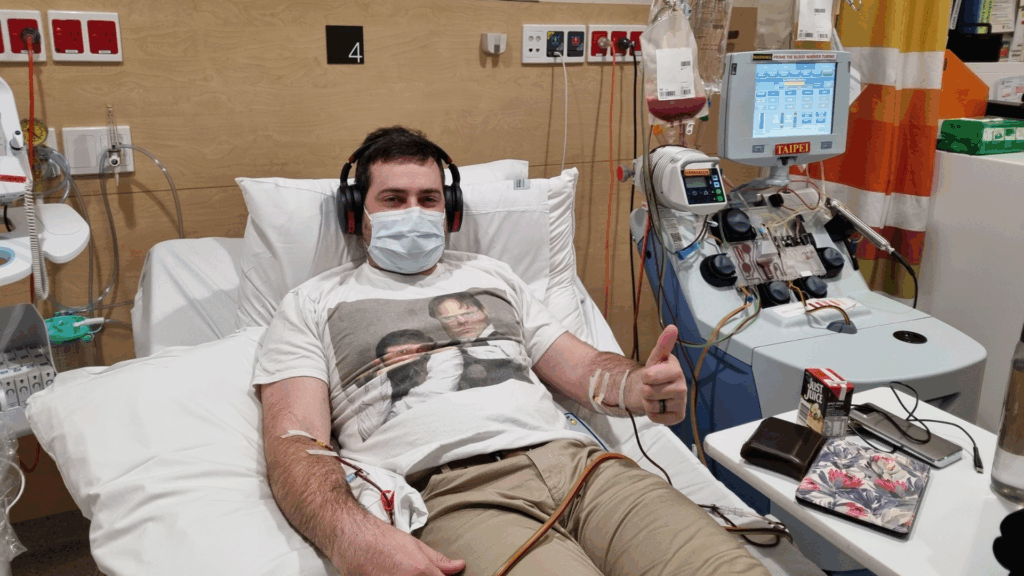If you’re thinking about signing up to donate stem cells, you’ve probably wondered: what does it do to my body?
This post breaks it down simply and honestly. It focuses mostly on Peripheral Blood Stem Cell (PBSC) donation, because that’s what most people experience in Australia. But we’ve included a section on bone marrow donation too.
The short version? For most people, it’s like a long plasma donation. You’ll feel a bit tired or achy, but you’ll recover quickly. And your body will replace what it gave, usually in a few weeks.
What happens to your body before donation
GCSF injections (PBSC donors only)
Before donation, you’ll get a daily injection called GCSF for four or five days. It helps your body produce more blood stem cells and move them into your bloodstream so they can be collected.
How it might feel
These injections are safe, but your body will be working harder than usual. You might feel:
- Aches in your lower back, hips, legs or shoulders
- Headaches or tiredness
- Mild flu-like symptoms
- Trouble sleeping
What happens during donation
PBSC donation (the most common type)

On donation day, you’ll be in a hospital or donation centre. You’ll be hooked up to a machine called an apheresis machine. Blood comes out of one arm, the stem cells are sieved out, and the rest of your blood is returned through the other arm.
You’ll have a soft plastic tube called a cannula in each arm, not a solid needle, so you can move about a little. All the donors we have spoken to say they are comfortable spending the time watching shows, chatting, or even snoozing.
The whole thing usually takes four to five hours, and you’ll be supported the entire time by a team of people who know what a legend you are.
What happens after donation
How you might feel
Most people feel tired or a bit achy for a day or two. You might have some bruising or soreness in your arms where the cannulas were. If you had GCSF injections, you might still feel some lingering muscle or bone aches, especially in your lower back or legs.
A couple of simple Paracetamol tablets usually clears everything up, and most people are back to normal within a day or two.
What your body does next
After you donate, your body naturally replaces the stem cells you gave. That process usually takes a few weeks, and it happens without you needing to do anything.
Your body is constantly making new blood and immune cells. Giving some away doesn’t drain your system, it just nudges your body to top things up.
Bone marrow donation
Bone marrow donation is much less common. Fewer than 10 percent of donors are asked to donate this way, usually when the patient is a baby or small child with very specific types of cancer. In those cases, stem cells from bone marrow can offer the best outcome.
If you’re ever asked to donate this way, a doctor will collect the stem cells from your hip bone while you’re under a general anaesthetic. You’ll be out cold for about 45 minutes and won’t feel a thing during the procedure.
Most donors will have a bit of a sore bum at the collection point for a week or two.
Doctors might recommend a certain method depending on what is best for the patient, but the choice is always yours.
No matter how you donate, you could be the reason someone with blood cancer gets a second chance at life.
Thinking about signing up?
If you’re aged 18 to 35 and generally healthy, you can sign up online in just a few minutes. A cheek swab kit will be sent to your home, where for many it will sit for weeks until you remember that you are a legend.
And one day, you might be the match someone is waiting for.
You can learn more and sign up here: https://stemcelldonors.org.au/about/partners/tlr-foundation/
References
TLR Foundation – Become a stem cell donor
Stem Cell Donors Australia – The donation process
Leukaemia Foundation – Blood stem cell (bone marrow) donation